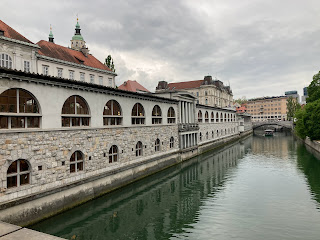Today would have been a good day to sleep in. Those of our group who are flying back to the U.S. tomorrow went to get the required Covid tests (everyone was negative), so the rest of the group did not gather with them until 10:45 a.m.
We used the time to do some walking and exploring. On Sunday morning, very few things were open and very few people were in the old city center. The sun was shining (even though the forecast had been for rain) so it was very pleasant and we had the city to ourselves.
First stop was the "pink church," as it it known to tourists because of its color, next door to our hotel. Officially the Church of the Annunciation of Mary, it is known to most locals as the "Franciscan Church" because a Franciscan monastery is next door. So it is a church with three names. People were just arriving for mass, so we just slipped in for a few minutes to look things over.
We walked on, past the historic opera house, and found the Church of Saints Cyril and Methodius. If one could not guess by the name, this is the main Orthodox church in Ljubljana.
The service was already in progress, and the place was packed. Standing room only -- not only because Orthodox churches often don't have pews, but because there were a lot of people. We stood together at the back until I noticed that I was surrounded by women, and men were on the other side. So I stepped over.
From here it was only a few steps into Ljubljana's Tivoli Park (yes, same name as the famous park in Copenhagen, Denmark). The guidebooks describe this park as "sprawling," and it certainly is. We only saw a small portion of it, because we could have walked around in it all day.
Originally the manor house of a noble, the Art Center is the main feature of the small corner of the park we were able to explore. A couple observations: Europeans don't cut their grass nearly as often as we do in the U.S. and art is everywhere, including many sculptures scattered in parks, as well as around the city.
Time was slipping by, so we walked an "alternate route" back toward the city center. Along the way, we saw a very interesting old building and decided to walk closer to take a look. It turned out to be the U.S. Embassy to Slovenia. The guidebook calls it "the quaintest embassy in Europe." But the German embassy, in the house next door, probably gives it a run for the title.
In the old city we visited the Katedrala Sv. Nikolaja -- the Cathedral of Saint Nicholas. The main entrance was closed and we were directed to a side door, which forced us basically to enter at the front of the church, where everyone could see that we were late for mass!
The service was just ending as we arrived. We scrambled for a pew and stood with the rest of the congregation for the final blessing. But then we got to sit for a very nice organ postlude as everyone else left.
We returned to the hotel and joined the group to walk to a place on the River Ljubljanica where an excursion boat was waiting for us. We got on board for a 45 minute cruise, and we were served a glass of sparkling white wine.
The cruise was pleasant enough, but the wine was really the high point. There wasn't a lot to see from the river that we hadn't already seen from above.
That was it for the day, as far as group activity. A few of us walked through the Sunday flea market, looking at tables full of antiques and collectables. Then we strolled back to the hotel.
A bit later, we went out and sat at an outdoor cafe, the two of us enjoying our wine and beer and watching the crowds pass by. The city had become much more active on a beautiful spring Sunday afternoon.
Slovenia has a goal of becoming the "greenest" (most environmentally friendly) nation in Europe, and Ljubljana is trying to be a leader in this. It's the first place we've seen electric car charging stations in any number. Also, in the pedestrian area of the old city, if you get tired of walking you can flag down one of these little electric taxis that will take you pretty much wherever you want to go. And they're free!
 |
| Our tour group, with the mayor of Ljubljana, on the steps of the city hall from our tour a couple days ago. |
At 5 p.m. our group reconvened for our farewell dinner.




















































